The Your Device Has Been Blocked pop-up alert is a misleading advertising that created in order to trick you into calling the fake Support Service. If you are seeing those “Your Device Has Been Blocked” fake alerts in the Chrome, Edge, Internet Explorer and Firefox every time you use the web-browser to surf the Internet, then it is possible that an undesired software from the adware (also known as ‘ad-supported’ software) family get installed on your machine. The adware looks the entire traffic generated by you and on this basis, it opens a ton of undesired pop up advertisements including misleading ads like those “Your Device Has Been Blocked” pop-ups. Currently, this adware are widely spread, due to the fact that most people are trying to find free software, download and install them on the PC without proper attention to the fact that an adware can be installed onto the PC system along with them.
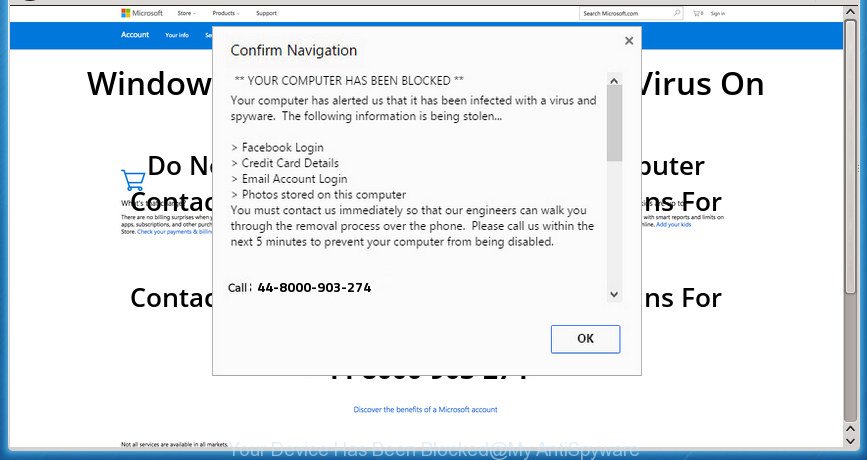
The “Your Device Has Been Blocked” is a misleading advertising like shown on the image above
The adware which causes misleading “Your Device Has Been Blocked” pop up on your web browser, may inject a lot of ads directly to the web pages that you visit, creating a sense that the advertising banners have been added by the makers of the web site. Moreover, a legal advertising banners may be replaced on the fake advertisements, that will offer to download and install various unnecessary and harmful applications.
Even worse, the ad supported software be able to collect lots of user info about you (your ip address, what is a site you are viewing now, what you are looking for on the World Wide Web, which links you are clicking), which can later transfer to third parties.
Instructions that is shown below, will help you to clean your PC system from the adware as well as remove “Your Device Has Been Blocked” unwanted popup advertisements from the Chrome, MS Edge, Firefox and Microsoft Internet Explorer and other web browsers.
Remove “Your Device Has Been Blocked” pop up scam
There exist several free ad-supported software removal utilities. Also it is possible to remove “Your Device Has Been Blocked” pop-up scam manually. But we suggest to combine all these ways below into the one removal algorithm. Follow the steps of the instructions. Read it once, after doing so, please print this page as you may need to exit your browser or reboot your machine.
To remove “Your Device Has Been Blocked”, execute the steps below:
- How to get rid of “Your Device Has Been Blocked” fake alerts without any software
- Delete questionable programs using MS Windows Control Panel
- Get rid of “Your Device Has Been Blocked” pop-up warnings from Microsoft Internet Explorer
- Remove “Your Device Has Been Blocked” fake alerts from Chrome
- Get rid of “Your Device Has Been Blocked” from Mozilla Firefox by resetting internet browser settings
- Remove unwanted Scheduled Tasks
- Disinfect the browser’s shortcuts to remove “Your Device Has Been Blocked” redirect
- Remove “Your Device Has Been Blocked” pop-up scam with free software
- Use AdBlocker to stop “Your Device Has Been Blocked” and stay safe online
- Method of “Your Device Has Been Blocked” pop up warnings intrusion into your computer
- Finish words
How to get rid of “Your Device Has Been Blocked” fake alerts without any software
The steps will help you delete “Your Device Has Been Blocked” pop-up warnings. These “Your Device Has Been Blocked” removal steps work for the MS Edge, Internet Explorer, Firefox and Chrome, as well as every version of MS Windows operating system.
Delete questionable programs using MS Windows Control Panel
First, you should try to identify and remove the application that causes the appearance of undesired advertisements or browser redirect, using the ‘Uninstall a program’ which is located in the ‘Control panel’.
Windows 10, 8.1, 8
Click the Microsoft Windows logo, and then press Search ![]() . Type ‘Control panel’and press Enter as shown below.
. Type ‘Control panel’and press Enter as shown below.

After the ‘Control Panel’ opens, press the ‘Uninstall a program’ link under Programs category as on the image below.

Windows 7, Vista, XP
Open Start menu and select the ‘Control Panel’ at right like below.

Then go to ‘Add/Remove Programs’ or ‘Uninstall a program’ (Microsoft Windows 7 or Vista) as displayed on the image below.

Carefully browse through the list of installed apps and remove all questionable and unknown software. We recommend to click ‘Installed programs’ and even sorts all installed programs by date. After you have found anything dubious that may be the ‘ad supported’ software which created to show misleading “Your Device Has Been Blocked” pop-up warnings within your web browser or other PUP (potentially unwanted program), then select this program and press ‘Uninstall’ in the upper part of the window. If the questionable program blocked from removal, then use Revo Uninstaller Freeware to fully get rid of it from your personal computer.
Get rid of “Your Device Has Been Blocked” pop-up warnings from Microsoft Internet Explorer
In order to recover all internet browser search provider by default, home page and new tab you need to reset the Internet Explorer to the state, which was when the Windows was installed on your machine.
First, start the IE. Next, press the button in the form of gear (![]() ). It will display the Tools drop-down menu, click the “Internet Options” like below.
). It will display the Tools drop-down menu, click the “Internet Options” like below.

In the “Internet Options” window click on the Advanced tab, then press the Reset button. The Internet Explorer will display the “Reset Internet Explorer settings” window as shown below. Select the “Delete personal settings” check box, then click “Reset” button.

You will now need to restart your system for the changes to take effect.
Remove “Your Device Has Been Blocked” fake alerts from Chrome
Run the Reset browser utility of the Chrome to reset all its settings such as new tab, startpage and default search engine to original defaults. This is a very useful tool to use, in the case of web-browser redirects to intrusive ad web-pages such as “Your Device Has Been Blocked”.

- First, start the Google Chrome and press the Menu icon (icon in the form of three dots).
- It will display the Chrome main menu. Choose More Tools, then click Extensions.
- You’ll see the list of installed add-ons. If the list has the addon labeled with “Installed by enterprise policy” or “Installed by your administrator”, then complete the following guidance: Remove Chrome extensions installed by enterprise policy.
- Now open the Chrome menu once again, click the “Settings” menu.
- Next, click “Advanced” link, which located at the bottom of the Settings page.
- On the bottom of the “Advanced settings” page, click the “Reset settings to their original defaults” button.
- The Google Chrome will open the reset settings prompt as shown on the image above.
- Confirm the web-browser’s reset by clicking on the “Reset” button.
- To learn more, read the post How to reset Chrome settings to default.
Get rid of “Your Device Has Been Blocked” from Mozilla Firefox by resetting internet browser settings
If the Mozilla Firefox internet browser program is hijacked, then resetting its settings can help. The Reset feature is available on all modern version of Mozilla Firefox. A reset can fix many issues by restoring Firefox settings such as search engine by default, homepage and new tab to its default state. It will save your personal information such as saved passwords, bookmarks, and open tabs.
Click the Menu button (looks like three horizontal lines), and press the blue Help icon located at the bottom of the drop down menu as displayed on the screen below.

A small menu will appear, press the “Troubleshooting Information”. On this page, press “Refresh Firefox” button as shown on the screen below.

Follow the onscreen procedure to revert back your Firefox web-browser settings to its original state.
Remove unwanted Scheduled Tasks
If the unwanted “Your Device Has Been Blocked” web-page opens automatically on Windows startup or at equal time intervals, then you need to check the Task Scheduler Library and get rid of all the tasks that have been created by ‘ad-supported’ application.
Press Windows and R keys on your keyboard simultaneously. It will show a prompt that called Run. In the text field, type “taskschd.msc” (without the quotes) and press OK. Task Scheduler window opens. In the left-hand side, click “Task Scheduler Library”, as shown in the following example.
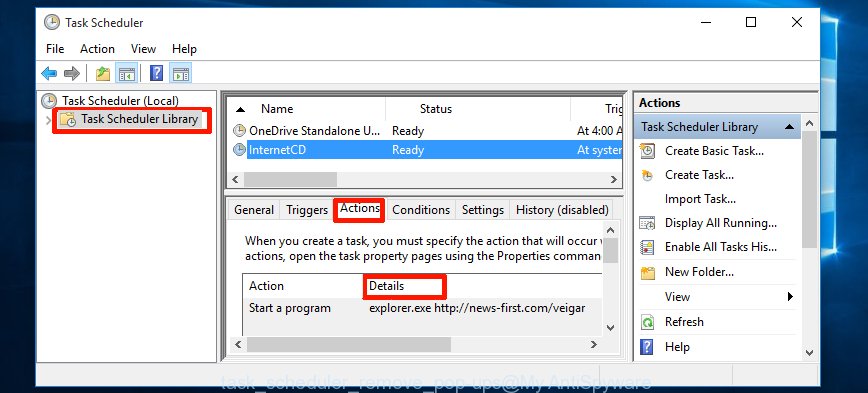
Task scheduler, list of tasks
In the middle part you will see a list of installed tasks. Select the first task, its properties will be display just below automatically. Next, click the Actions tab. Necessary to look at the text which is written under Details. Found something like “explorer.exe http://site.address” or “chrome.exe http://site.address” or “firefox.exe http://site.address”, then you need remove this task. If you are not sure that executes the task, then google it. If it’s a component of the unwanted software, then this task also should be removed.
Further press on it with the right mouse button and select Delete like below.

Task scheduler, delete a task
Repeat this step, if you have found a few tasks that have been created by unwanted programs. Once is done, close the Task Scheduler window.
Disinfect the browser’s shortcuts to remove “Your Device Has Been Blocked” redirect
Unfortunately, the adware that causes misleading “Your Device Has Been Blocked” popup scam on your web browser, can also hijack Windows shortcut files (mostly, your internet browsers shortcut files), so that the “Your Device Has Been Blocked” ad web site will be displayed when you start the Edge, Chrome, Mozilla Firefox and Internet Explorer or another internet browser.
Right click on the internet browser’s shortcut, click Properties option. On the Shortcut tab, locate the Target field. Click inside, you will see a vertical line – arrow pointer, move it (using -> arrow key on your keyboard) to the right as possible. You will see a text “http://site.address” that has been added here. Remove everything after .exe. An example, for Google Chrome you should remove everything after chrome.exe.

To save changes, press OK . You need to clean all internet browser’s shortcuts. So, repeat this step for the MS Edge, Firefox, Chrome and Internet Explorer.
Remove “Your Device Has Been Blocked” pop-up scam with free software
If your computer is still infected with adware that causes web browsers to open misleading “Your Device Has Been Blocked” pop-up, then the best way of detection and removal is to use an antimalware scan on the machine. Download free malicious software removal tools below and launch a full system scan. It will allow you remove all components of the adware from hardisk and Windows registry.
Remove “Your Device Has Been Blocked” popup with Zemana Anti-malware
Zemana Anti-malware is a utility that can delete ad-supported software, PUPs, hijackers and other malware from your personal computer easily and for free. Zemana Anti-malware is compatible with most antivirus software. It works under Windows (10 – XP, 32 and 64 bit) and uses minimum of personal computer resources.
Download Zemana Free on your personal computer from the following link.
164818 downloads
Author: Zemana Ltd
Category: Security tools
Update: July 16, 2019
When the download is done, close all windows on your system. Further, open the install file called Zemana.AntiMalware.Setup. If the “User Account Control” prompt pops up as displayed in the figure below, press the “Yes” button.

It will display the “Setup wizard” that will allow you install Zemana Free on the computer. Follow the prompts and do not make any changes to default settings.

Once installation is done successfully, Zemana Anti-Malware will automatically start and you may see its main window like below.

Next, press the “Scan” button for scanning your machine for the ad-supported software that developed to show misleading “Your Device Has Been Blocked” fake alerts within your web browser. This process can take some time, so please be patient. While the Zemana AntiMalware utility is checking, you can see how many objects it has identified as being affected by malware.

Once the scan get finished, you can check all items detected on your computer. Next, you need to click “Next” button.

The Zemana will remove adware that causes misleading “Your Device Has Been Blocked” fake alerts on your web browser and move threats to the program’s quarantine. Once disinfection is finished, you can be prompted to reboot your system.
Use Malwarebytes to delete “Your Device Has Been Blocked” pop-up warnings
We suggest using the Malwarebytes Free. You can download and install Malwarebytes to detect ad supported software and thereby remove “Your Device Has Been Blocked” pop-up scam from your web-browsers. When installed and updated, the free malicious software remover will automatically check and detect all threats present on the PC system.
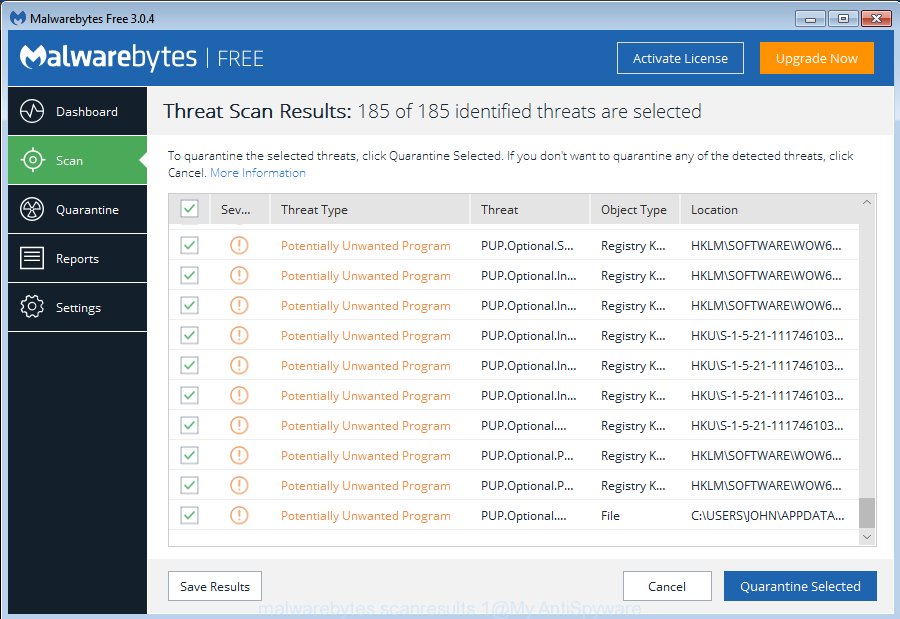
Visit the page linked below to download the latest version of MalwareBytes AntiMalware (MBAM) for Windows. Save it to your Desktop.
327074 downloads
Author: Malwarebytes
Category: Security tools
Update: April 15, 2020
After downloading is done, run it and follow the prompts. Once installed, the MalwareBytes will try to update itself and when this procedure is finished, click the “Scan Now” button to perform a system scan with this tool for the adware which causes misleading “Your Device Has Been Blocked” pop up warnings on your web-browser. While the MalwareBytes Free utility is checking, you can see count of objects it has identified as being infected by malware. In order to remove all items, simply click “Quarantine Selected” button.
The MalwareBytes AntiMalware (MBAM) is a free program that you can use to get rid of all detected folders, files, services, registry entries and so on. To learn more about this malware removal tool, we recommend you to read and follow the step-by-step tutorial or the video guide below.
If the problem with “Your Device Has Been Blocked” fake alerts is still remained
AdwCleaner is a free portable program that scans your personal computer for adware that causes multiple misleading “Your Device Has Been Blocked” alerts and popups, potentially unwanted programs and browser hijacker infections and allows delete them easily. Moreover, it will also allow you remove any harmful web-browser extensions and add-ons.
Visit the following page to download the latest version of AdwCleaner for MS Windows. Save it on your Windows desktop or in any other place.
225547 downloads
Version: 8.4.1
Author: Xplode, MalwareBytes
Category: Security tools
Update: October 5, 2024
When downloading is done, open the file location and double-click the AdwCleaner icon. It will launch the AdwCleaner tool. If the User Account Control prompt will ask you want to launch the program, click Yes button to continue.
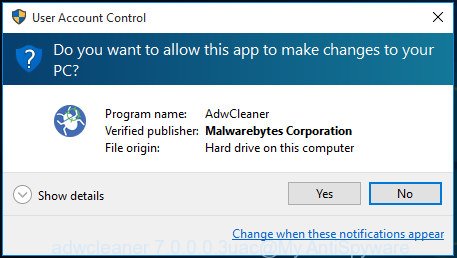
Next, click “Scan” for scanning your personal computer for the ad supported software that cause misleading “Your Device Has Been Blocked” pop up warnings to appear. This process may take some time, so please be patient. While the AdwCleaner tool is scanning, you can see how many objects it has identified as being infected by malicious software.
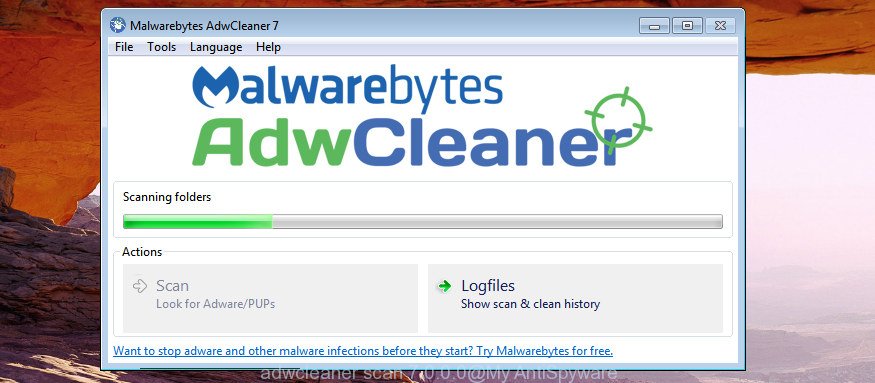
Once AdwCleaner has finished scanning your machine, AdwCleaner will prepare a list of unwanted and ad supported software programs as displayed in the following example.
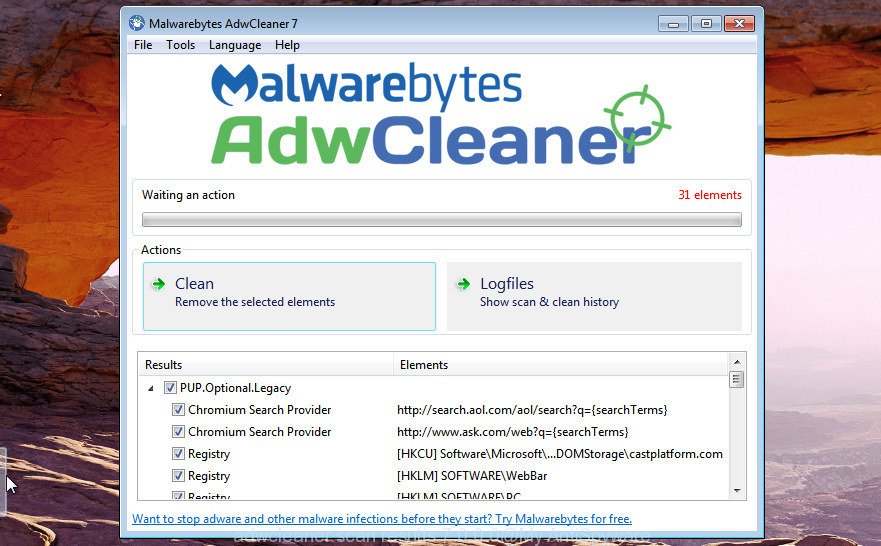
Next, you need to click “Clean” button. It will display a dialog box. Click “OK” button. The AdwCleaner will begin to get rid of adware that cause misleading “Your Device Has Been Blocked” pop-up to appear. After finished, the tool may ask you to reboot your computer. After restart, the AdwCleaner will open the log file.
All the above steps are shown in detail in the following video instructions.
Use AdBlocker to stop “Your Device Has Been Blocked” and stay safe online
Using an adblocker program like AdGuard is an effective way to alleviate the risks. Additionally, ad-blocker applications will also protect you from harmful advertisements and sites, and, of course, block redirection chain to “Your Device Has Been Blocked” and similar web-sites.
Installing the AdGuard is simple. First you’ll need to download AdGuard on your machine by clicking on the link below.
26847 downloads
Version: 6.4
Author: © Adguard
Category: Security tools
Update: November 15, 2018
Once the downloading process is finished, double-click the downloaded file to run it. The “Setup Wizard” window will show up on the computer screen as displayed below.

Follow the prompts. AdGuard will then be installed and an icon will be placed on your desktop. A window will show up asking you to confirm that you want to see a quick tutorial as displayed on the screen below.

Press “Skip” button to close the window and use the default settings, or click “Get Started” to see an quick guide that will help you get to know AdGuard better.
Each time, when you start your PC, AdGuard will launch automatically and block pop ups, “Your Device Has Been Blocked” redirect, as well as other malicious or misleading web-pages. For an overview of all the features of the program, or to change its settings you can simply double-click on the AdGuard icon, that can be found on your desktop.
Method of “Your Device Has Been Blocked” pop up warnings intrusion into your computer
Many apps created to display lots of undesired advertisements within your computer’s browser. So, when you installing free applications, carefully read the disclaimers, select the Custom or Advanced install type to watch for optional programs that are being installed, because some of the applications are potentially unwanted applications like this ad-supported software that shows misleading “Your Device Has Been Blocked” pop-up on your system.
Finish words
Now your computer should be free of the ‘ad supported’ software that displays misleading “Your Device Has Been Blocked” pop-up on your machine. Delete AdwCleaner. We suggest that you keep Zemana Free (to periodically scan your computer for new ‘ad supported’ softwares and other malicious software) and AdGuard (to help you stop intrusive ads and harmful web-sites). Moreover, to prevent any adware, please stay clear of unknown and third party applications, make sure that your antivirus application, turn on the option to detect potentially unwanted applications.
If you need more help with “Your Device Has Been Blocked” pop up related issues, go to our Spyware/Malware removal forum.


















